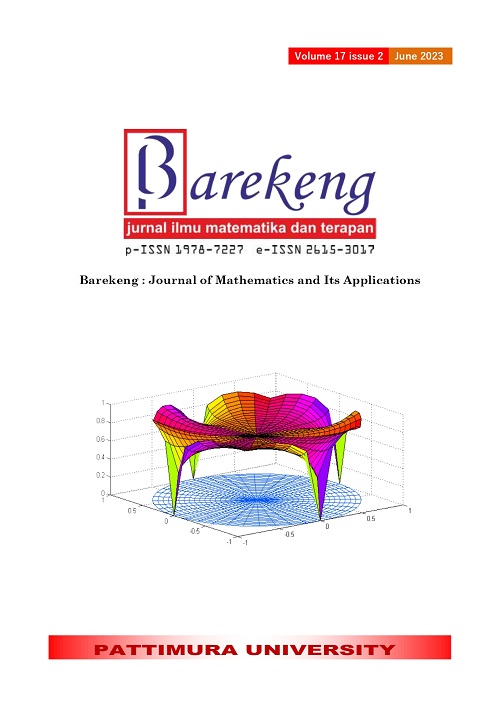GENERALIZED CONFIRMATORY FACTOR ANALYSIS FOR KNOWING IMPACT OF KNOWLEDGE, ATTITUDES, AND BEHAVIORAL FACTORS HIV/AIDS IN INDONESIA
Abstract
The cumulative number of detected HIV/AIDS cases in the January – March 2021 period is 9,327, consisting of 7,650 HIV and 1,677 AIDS reported by 498 districts and cities from 514 districts and cities in Indonesia. Human Immunodeficiency Virus (HIV) is the virus that causes Acquired Immunodeficiency Syndrome (AIDS). Several factors that influence the spread of HIV/AIDS include knowledge, attitudes and behavior about HIV/AIDS. Someone who gains knowledge about HIV/AIDS will have high self-confidence and a positive outlook on life and be more optimistic in taking HIV/AIDS prevention actions. The main objective of this study is to determine the influence of external factors which include demographic, social and economic aspects, as well as internal factors which include knowledge, attitudes and behavior to the level of transmission of HIV/AIDS. By using the CFA approach, it can be seen which indicators have the greatest influence on the latent variables of knowledge, attitudes, and behavior or called loading factors. The data used is secondary data from a 5-year survey from the Central Statistics Agency, namely the 2017 Indonesian Demographic and Health Survey (IDHS) published at the end of 2018. The CFA results show that the P11 variable (about known infections) has the largest loading factor value, which is 0.613 in the variable. . hidden. knowledge. In the latent variable of attitude, the S1 variable (about identifying how the respondent knows someone is infected with HIV-AIDS) has the largest loading factor value of 0.514. While the behavioral latent variable, the variable R8 (whether men have been infected with sexually transmitted diseases (STI) with symptoms) has the largest loading factor value, which is 0.954.
Downloads
References
B. P. S. &. K. K. Badan Kependudukan dan Keluarga Bencana Nasional, "Survei Demografi dan Kesehatan Indonesia (SDKI)," 2017.
E. N. Kontomanolis, S. Michalopoulos, G. Gkasdaris and Z. Fasoulakis, "The Social Stigma of HIV-AIDS: Society's Role," HIV/AIDS - Research and Palliative Care, vol. 9, pp. 111-118, 2017.
S. Elbe, Strategic Implications of HIV/AIDS, eBook ed., London: Routledge, 2020.
K. K. R. Indonesia, 2022. [Online]. Available: https://www.kemkes.go.id/article/view/21120200001/stigma-negatif-masyarakat-hambat-eliminasi-hiv-aids-di-indonesia.html.
Aslia, "Hubungan Pengetahuan dan Sikap Tentang HIV/AIDS dengan Tindakan Pencegahan HIV/AIDS Pada Remaja di SMA 2 Kota Bau-bau.," 2017.
S. Notoatmodjo, Pendidikan dan Perilaku Kesehatan, Jakarta: Rineka Cipta, 2003.
K. C. L. Gusti, B. W. Otok and S. Andari, Pengaruh Perilaku Pasien HIV/AIDS Terhadap Gambaran Klinis Menggunakan Finite Mixture in Partial Least Square (FIMIX-PLS) di Kabupaten Pasuruan, Surabaya, 2017.
S. J. Raharja and D. Akhmad, "Analisis Jaringan Kolaborasi dalam Pencegahan dan Penanggulangan HIV/AIDS: Studi di Kabupaten Subang Jawa Barat," Jurnal Kependudukan Indonesia, vol. 14, no. 1, pp. 29-48, Juni 2019.
B. Thanavanh, M. Harun-Or-Rashid, H. Kasuya and J. Sakamoto, "Knowledge, Attitudes and Practices Regarding HIV/AIDS Among Male High School Students in Lao People's Democratic Republic," JIAS Journal of The International AIDS Society, vol. 16, no. 1, p. 17387, 2013.
D. Sari, "Gambaran Pengetahuan, Sikap, dan Perilaku Mengenai HIV/AIDS Pada Mahasiswa Program Studi Pendidikan Dokter Universitas Tanjungpura," Jurnal Mahasiswa Fakultas Kedokteran Untan, 2013.
S. K. Opt and D. A. Loffredo, "College Students and HIV/AIDS: More Insights on Knowledge, Testing, and Sexual Practice," The Journal of Psychology, vol. 138, no. 5, pp. 389-403, 2004.
N. S. Rahmi, L. Amaliana, L. M. Pimada, R. Yesica and D. N. C. Ningsih, "Confirmatory Factor Analysis pada Indikator Kesembuhan Pasien Isolasi Mandiri Covid-19 di Indonesia," STATISTIKA Journal of Theoretical Statistics and Its Applications, vol. 22, no. 1, pp. 13-23, Mei 2022.
S. Lombardi, G. Santini, G. M. Marchetti and S. Forcadi, "Generalized Structural Equations Improve Sexual-selection Analysis," PLoS ONE, vol. 12, no. 8, pp. 1-20, 2017.
Solimun, A. A. R. Fernandes and Nurjannah, Metode Statistika Multivariat Pemodelan Persamaan Struktural (SEM), Malang: UB Press, 2017.
B. M. Byrne, Structural Equation Modeling with AMOS, London: Routledge, 2010.
B. Thompson, Exploratory and Confirmatory Factor Analysis: Understanding Concepts and Applications, American Psychological Association, 2004.
J. F. Hair, G. T. M. Hult, C. M. Ringle and M. Sarstedt, A Primer on Partial Least Squares Structural Equation Modeling (PLS-SEM), 3 ed., Sage Publishing, 2022.
Copyright (c) 2023 Nur Silviyah Rahmi, Suci Astutik, Ani Budi Astuti, Alifiandi Rafi Muhammad, Ulfah Maisaroh, Sri Handayani

This work is licensed under a Creative Commons Attribution-ShareAlike 4.0 International License.
Authors who publish with this Journal agree to the following terms:
- Author retain copyright and grant the journal right of first publication with the work simultaneously licensed under a creative commons attribution license that allow others to share the work within an acknowledgement of the work’s authorship and initial publication of this journal.
- Authors are able to enter into separate, additional contractual arrangement for the non-exclusive distribution of the journal’s published version of the work (e.g. acknowledgement of its initial publication in this journal).
- Authors are permitted and encouraged to post their work online (e.g. in institutional repositories or on their websites) prior to and during the submission process, as it can lead to productive exchanges, as well as earlier and greater citation of published works.






1.gif)



